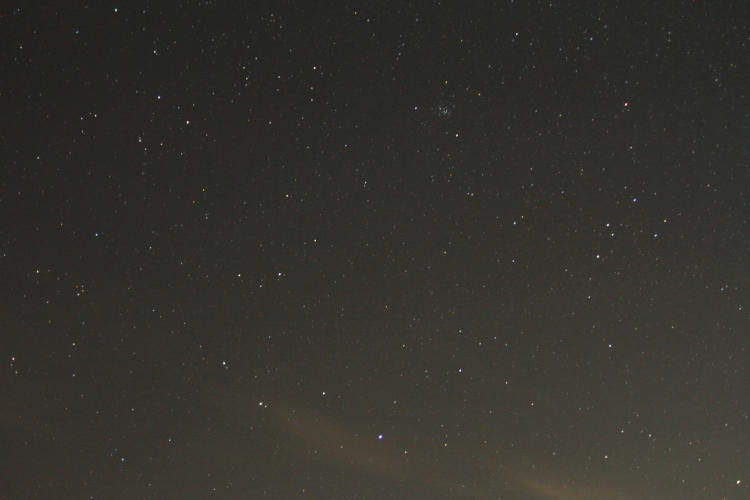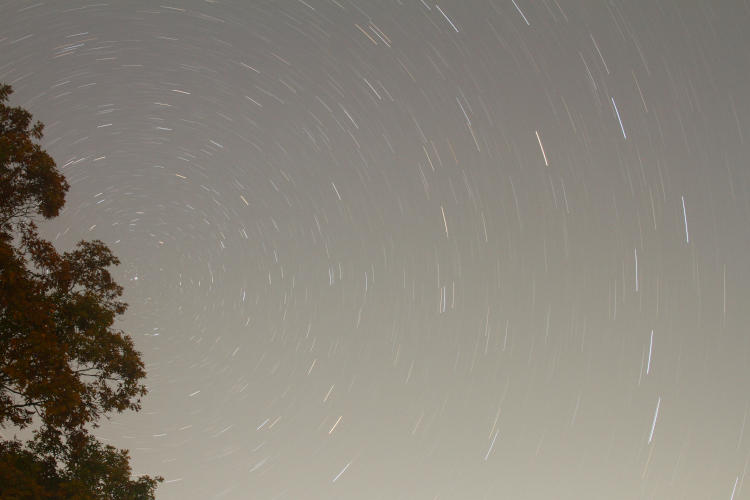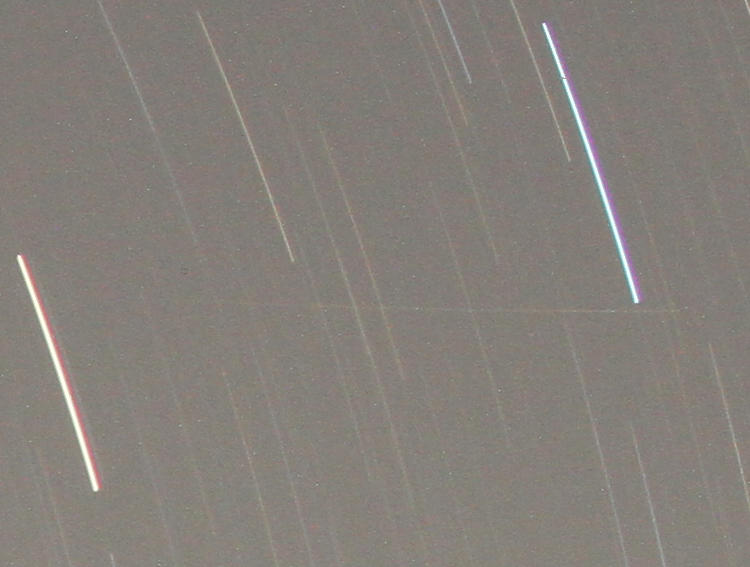Two posts back, I mentioned the Leonids meteor shower, and how it might be useful to go out earlier than the peak of the 17th/18th to see what could be found. I will smugly inform you that this was not a case of, “Do as I say, not as I do,” because I did go out to a dark sky location nearby, in the wee hours of the morning on the 11th (so, an hour or so after posting that,) and made an attempt. I’ve just been sitting on my ass since then without posting anything about it.
Well, I had a decent reason, in that I saw nothing, and captured nothing. Or almost nothing. I was experimenting a little, because I’ve had a Sigma 24-60 f2.8 lens for a while without using it much, since I have other lenses that cover better zoom ranges and the chief benefit, that maximum aperture of f2.8, is applicable in narrow circumstances, so I wasn’t carrying it routinely in my bag. But I thought it might give me an edge on getting shorter time exposures of the night sky and thus avoiding a lot of star streaks; maybe I’d even get a decent rendition of the Milky Way.
Alas, no.

First off, I was manually focusing of course, but at night such things have to be done on distant points of bright light (as in, brighter than stars,) and I only had one real choice, which I didn’t quite get pinned down. This showed me that the lens was notoriously bad about purple fringing, the diffraction effect that some lenses show, especially when focus isn’t quite on and you have bright objects (like stars) against a dark background (like space.) This frame doesn’t show it too bad; we’ll see worse in a second. This is almost centered on the origin point of the Leonids shower: the ‘radiant’ for most of the meteors sits just a bit left of absolute center, within that little inverted triangle of stars. You can also see the Beehive Cluster of stars just right of center, closer to the top of the frame. The smears at the bottom are just clouds close to the horizon. This was a 20 second exposure at ISO 1600, short enough not to streak the stars into lines unless you look at high magnification. But no meteors, throughout several frames and varying exposure times.

Here we get a better example of the purple fringing with Orion, that cluster of stars straight over the tree, but I did at least get the faintest hint of the prominent nebulae that sit around the dagger, those ‘three’ vertical stars. That’s in quotes because it’s a lot more than three stars in there, quite a mess really, but without magnification we pretty much see three. This was better than 90° away from the radiant, so not the best direction to be facing if the target was meteors, but the target was instead Orion, so it was precisely the direction to be facing. Not to mention that the sky was notably darker this way, so better definition of the stars. Well, it would have been, had the focus been better.

I stared at this one, and the plots within Stellarium, for quite some time trying to recall which direction I was facing, until I realized I might have been shooting vertically and trying for the Milky Way. Abruptly I pinned it down, since that’s the head and shoulders of Orion at the bottom, and the entire frame spans up through portions of Taurus, Gemini, and Auriga – the bright star at the top of the frame is Capella, if that helps. I’m not an astronomer, even an amateur, so this attempt to capture a portion of the Milky Way (which I knew was there even though I wasn’t seeing it too clearly) wasn’t destined for greatness because this faces out towards the edge of our galaxy, rather than towards the center; winter is not the time to be trying this, since the more distinct center, with its bulge and dust lanes, sits behind the sun in this season. There’s the faintest hint of it within this photo, but really, even in ideal conditions with a tracking motor, I wasn’t likely to capture much.
I did eventually refocus, and nailed it much better this time, so the next frames are less annoying. However, initial experiments told me to cut the ISO back down to 400, since this is a much longer exposure.

It’s always fun to do this, but I didn’t let it go very long, because I’d been up for a while and wasn’t willing to be out there a whole lot longer. This is a 20 minute exposure (actually one second shy,) framed with Polaris, the north star, right alongside the tree. Ursa Major was quite distinct, allowing me to find Ursa Minor without difficulty, and that’s where Polaris sits. This is the motion of the Earth spinning while looking straight out over the axis point, what would be directly overhead were we standing at the North Pole. At full resolution, it becomes clear that Polaris isn’t the focus of the arcs – it’s just close. Meanwhile, the brighter stars towards the right side of the frame are Ursa Major, the Big Dipper. And, we have the only potential evidence of success from the night in there, but we can’t see it at this resolution, so we go in close to the two end stars of the ‘scoop’ of Ursa Major – that would be Dubhe and Merak, for the record.

Sitting perfectly horizontal in the frame, my old-ass photographer’s instincts tell me this is a scratch in the film before my rational brain kicks in and points out that this is a digital image, granpa. So, something out there actually made this faint streak, but whether it was a meteor or a bit of manmade orbiting material is up for grabs. I did run Stellarium back and forth through that timeframe to see if any known satellites were cruising through, and got a Delta rocket booster, but well after the period that this image was exposing for, and not quite in line either. Right now I’m more inclined to say this was still human debris rather than cosmic, given that I saw nothing at all that night despite the dark conditions and the amount of time that I was staring at the sky – it was not an active period, for sure.
So, will I try again before peak? Not sure, really – the moon, as it does, is setting close to an hour later every night, so it’s already setting about 2:30 am tomorrow morning, starting to cut into the prime viewing periods. I’d have to be out within the next two nights/mornings to make it worthwhile. We’ll see, I guess.




















































